A rich, mushroom aioli made from dried, toasted porcini mushrooms is a creative way to use up your dried mushroom stash. Read on and I'll explain what it is, how to make it and use it.
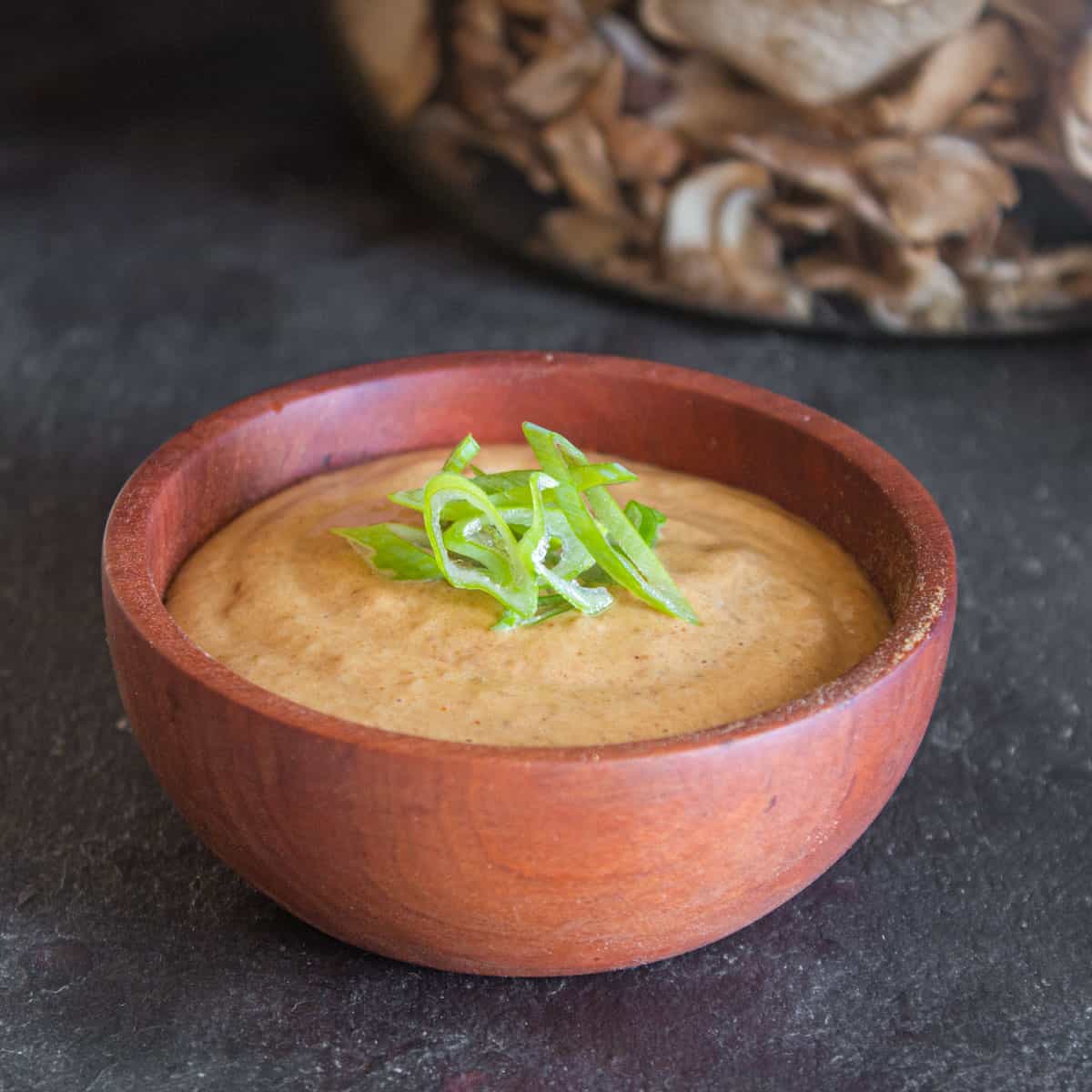
During the Winter after a really good year for boletes (likely the legendary Pallidoroseus haul of 2013) I started making all kinds of things with my dried shrooms. Cooking with European porcini is easy: just throw them in anything and the flavor will take over. The porcini I pick in Minnesota (Boletus atkinsonii, or whatever mix of porcini-type fungus they are) though, don't share the intense flavor of their European cousins, but they're our porcini, and, they're free.
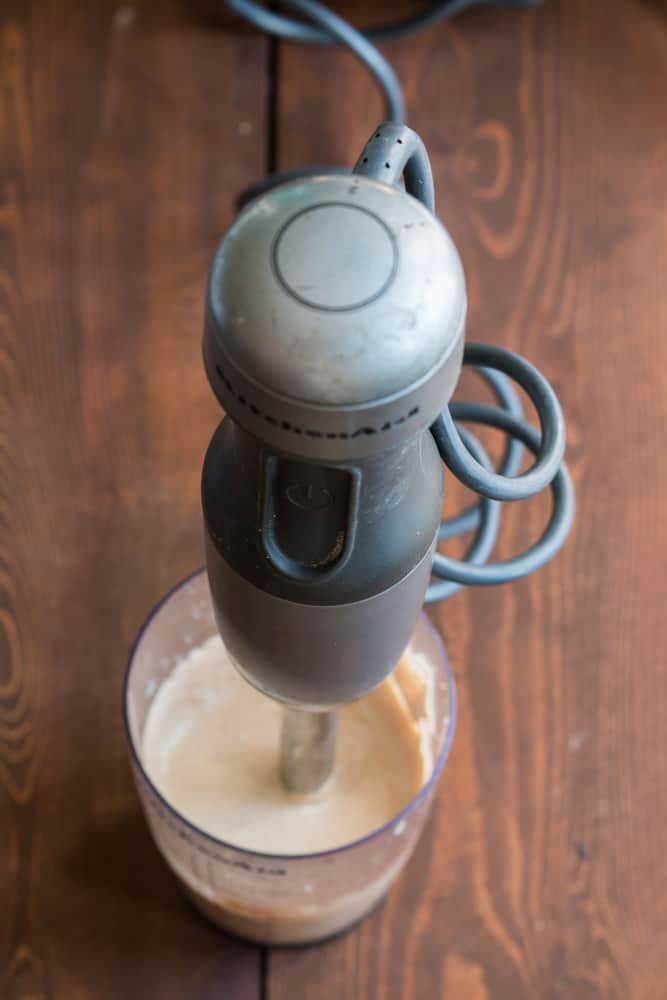
One thing that worked well was this toasted porcini aioli. Typically you might not thing of using mushrooms to make a condiment, but cooking the garlic to calm it, and toasting the mushrooms makes their flavor punchy enough to dress up just about anything that would taste good with a mayonnaise-y something.
Boletes still being precious, I'm more likely to use it as a condiment for roasted potatoes or a bite of whitefish than I am to smear it on a sandwich.
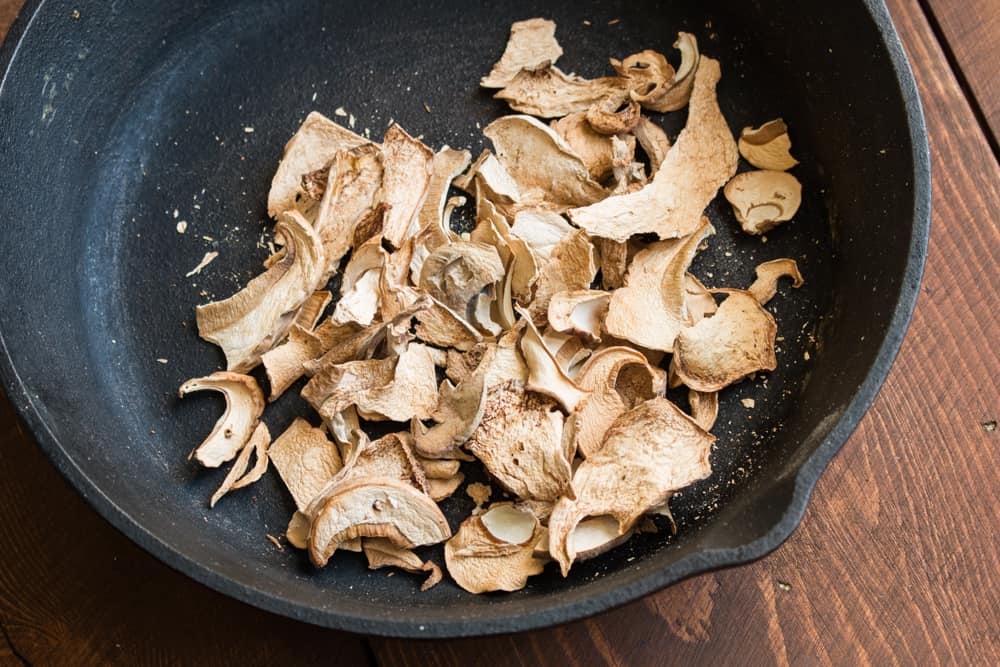
On Toasting Mushrooms
The key idea here: toasting the porcini to help bring out different, fresh aromas, will coax rich flavors from even the lightest tasting boletus, and (if you like them) I'd wager toasting your favorite species of Suillus would help it not taste as skunky as they do naturally, too.
Basically, toasting mushrooms makes them taste good, and here, makes the porcini flavor strong enough to make a decent condiment. Make sure not to overcook the mushrooms in the oven though (easier said than done), since dried things burn, very fast.
Try setting a timer at 2-3 minute intervals, and inspecting the mushrooms as they gently change color and the flavor changes. Watch them closely and you'll understand the process, and you'll know exactly when they start to smell toasty and delicious.
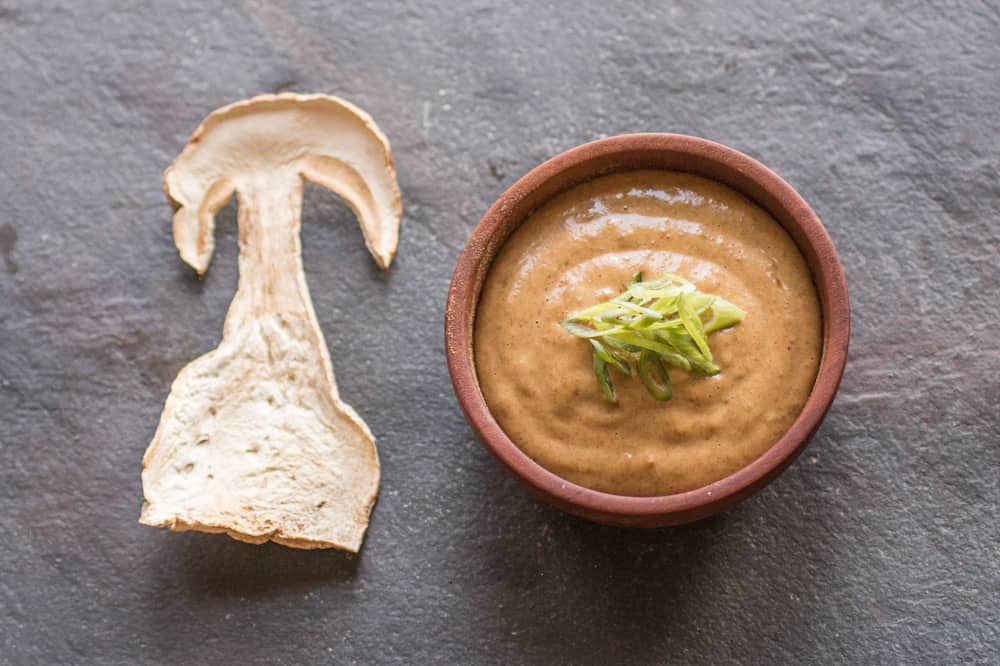
Like a typical flavored mayonnaise, the other flavors you'd expect here, namely garlic, oil and acid are along for the ride with a few capers to add a little funk, as well as some extra mass.
Correctly pureeing and adding the oil isn't difficult, but if you're never done it before, it may be a little awkward, since you'll be doing this with a hand blender and it's basically the smallest amount of aioli you can possibly make. If you add the oil too fast and break it you'll end up with a loose, soupy mess, but have faith in yourself-it's not rocket science.
Toasted Porcini Aioli
Equipment
- Hand blender, or small food processor
Ingredients
- ¾ cup mild tasting oil add a little more or less to adjust the consistency
- ½ oz dried porcini about ½ cup crumbled dried mushrooms
- 20 grams garlic cloves about 2 large cloves
- 5 g capers
- 1 large egg
- 2 Tablespoons Hot water
- ¾ oz or 2 Tablespoons fresh lemon juice
- ½ teaspoon salt plus more to taste
Instructions
- Toast the lightly porcini in the oven until fragrant and lightly browned, be careful not to over-toast, which could make the aioli bitter. Grind to a powder and reserve, and put the powder in a container you will blend the aioli. Add 2 Tablespoons of hot water to the mushrooms.
- Meanwhile, cook the garlic cloves in a few inches of water until soft, about 15 minutes, then remove and cool, discarding the cooking liquid.
- In a food processor or with a hand blender, combine the lemon, capers, egg, garlic, and porcini powder and puree, then begin drizzling in the oil.
- When the oil has been added and the mixture is thick and velvety, transfer to a container and refrigerate. If you like it a little thicker, you can probably fit a little extra oil in the aioli, just take it slow. The aioli will keep for 5 days.

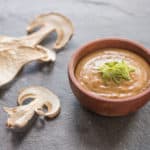
Erik Jones
You mentioned the "legendary Pallidoroseus haul". I found and dried a big patch of some beautiful boletes I believe to be pallidoroseus (they look a lot like paler/pinker bicolor boletes with less vivid yellow on the stem.) What did you end up doing with your pallidoroseus?
Alan Bergo
They have a new name and it's escaping me. They are one of the finest boletes for drying. They have an aroma of beef bouillon. Ah, I got it, it's Lanmoa palladoroseus now.
Pete Hautman
Alan, (This is sort of a long comment—I’m suffering from the fungi-forager’s winter withdrawal blues.) Regarding your observation about the European vs. our local porcini: Yes, absolutely, the dried old world boletes have a lot more flavor than the “kings” I dry at home. But I’m wondering why. When I buy a bag of imported boletes (the last bunch I purchased was from Kramarczuk’s) and examine them, I do not believe they are all Boletus edulis. In fact, I’d bet those pickers throw many different types of boletes into the dryer. So I’m wondering how much of the difference is due to species (or terroir), and how much it’s due to the way they are processed.
Last fall I served some raw king bolete (the kind that grow under oaks here) to a food-loving couple who had just been in Italy and enjoyed the same type of dish. They swore that they tasted exactly the same. That, too, made me wonder about how much the drying method affects flavor.
If I get lucky with the porcini this next season, I may try mixing up my drying technique: some sun dried, some slow-dried on a rack, some dried at a higher temperature in the dehydrator, etc. Any thoughts?
Alan Bergo
Pete, good to hear from you. I've been in AZ, sorry for being pokey here. Yeah, I wondered about this ever since I picked my first Midwestern kings. I expected them to taste like the ones I always bought wholesale and was disappointed. I would hesitate to use flavor of two different cini raw as a barometer for flavor. After different fresh porcini-types, from the PNW, Midwest, CO, and a couple markets in Southern France, I have to say that blindfolded, in a taste test, I'd probably be hard-pressed to tell the difference between all of them--they all taste really good. I think the real character comes out as they lose water. But, obviously, I haven't done experiments like you're talking about here, that would be a great study. Please let me know if you do that this year.
One thing I notice, now that I think of it, is that the Old World porcini are always sliced thicker than I would slice mushrooms to dry, since I'm usually filling the dehydrator and want them to dry as fast as possible. They're darker in color too, and always have a healthy amount of pores. I think sun drying would be a great experiment. I think it's reaching a bit, but lower drying in the sun could potentially encourage enzymatic reactions (as opposed to bacterial decomposition) that can alter flavors and create different flavors. I've never done it, and I've never heard of it, but similar food analogies are there.
The best example I can think of is conventional wild rice vs parched wild rice. Conventional wild rice is allowed to dry naturally, which causes fermentation. The plant hardens the outside of the grass/seed kernel in order to preserve the seed viability, but it absorbs strong fermented aromas as it does it. This is why parched wild rice tastes completely different than parched wild rice, and takes at least 3 times longer to cook. Obviously totally different botanical subjects here but it's the best example I could think of.
Let me know if you play around with that, and good luck with the blues! A
David Griggs
Alan, thanks for the wonderful inspiration. My King Bolete patch has a tone of slugs.....They seem to enjoy them as much as I do. This is a great way to use mushrooms that may be just fine to consume, but be a we bit cosmetically unappealing to certain folks.
Just wondering: have you ventured into the realm of insects as a food option?
Alan Bergo
Thanks David. I used to laugh at entomophagy with the exception of a few Latin American traditions (chapulines). But, then I met someone who was a long time vegan, and then a frutarian for 6-7 years straight. Faced with endocrine disruption (it made her infertile), malnutrition, jaundice, and everything else that can go with it, she explained to me that consuming bugs were the first tiny step she took to break the stranglehold that veganism can have on people. Years later, she hunts bears. Now, I feel like it's definitely a worthwhile cause, and insect are likely the most sustainable protein source on the planet. Don't expect waterbug snacks from me though. 🙂
Glenn Freeman
How would you make this recipe Vegan? What might be a good egg substitute here? Leave out the eggs? TOOM is vegan ... just another type of Mayo, which does not require eggs.
Alan Bergo
Asking me that will open a can of worms, so sorry in advance--it's not personal. I've worked as a consultant for big name vegan food companies experimenting mushroom tissue, so I've seen the innerworkings. I support regenerative agriculture and naturally raised meat. Vegan products, meat based alternatives, and the like displace and kill animals via habitat loss and are just as bad as conventional agriculture. That being said, if you want to make vegan mayonnaise alternatives, google "flax seed eggs". Alan.
Glenn Freeman
Eat all the meat you like ... I asked a simple question. Food is food, and cooking is cooking ... what can of worms are you talking about? Anyway, I'm guessing firm tofu might work very well in this recipe ... or another 'gooey' egg alternative. Flax eggs would not work well in this context, nor for vegan mayo either. I guess you've not done much vegan adaptations. No problem. Flax eggs sometimes work well in baking contexts. Not everyone eats meat, nor should they be expected too. I do not expect anyone else to be vegan
Alan Bergo
Thanks for being open minded. I'm just a loudmouth on the subject, and I mean no offense. And yeah, anything that can soak up oil can work, or even just hydrating toasted mushroom powder with splash of boiling water and folding into prepared mayo/equivalent.
John Smalldridge
Whenever you post something about boletes I’m all over it. I really like your creativity with mushrooms. The boletes that I like to dry locally are really mature boletus separans. To me these seem to have the best aroma and flavor. Have you tried them dried before?
Alan Bergo
Thanks John. No, I haven't tried them. There are so many boletes to try. A real gift to us mushroomers.
Marla Micoley
Amazing post Chef!! Such a great idea for another option with a porcini or other wild mushrooms.
Thanks for the inspiration!
Marla
Alan Bergo
You're welcome.